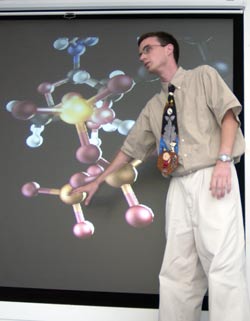 $100,000 Champlin Foundations grant provides latest animation technology
$100,000 Champlin Foundations grant provides latest animation technology
KINGSTON, R.I. — October 27, 2004 — Powerful computer technology made possible the creation of such animated film hits as Shrek and Finding Nemo.
Now, thanks to a $100,000 grant from the Champlin Foundations, the University of Rhode Island College of Pharmacy has similar computer animation technology that helps students see and understand how Prozac works, how an antiviral drug inhibits AIDS and how drug metabolism works in bright, dynamic, living color. And if a dozen URI pharmacy professors and another dozen students have their way, those projects are only the beginning.
“The core of this project is that students and faculty have come together to create animation segments that can be used to illustrate important and hard to understand biomedical concepts,” said pharmacy Professor Bongsup Cho, the lead faculty member of the project. Pharmacy Professors Keykavous Parang and Clinton Chichester are also playing major roles in the project. “Right now most of it is pharmacy related, but we want to expand the program to include chemistry, biochemistry, engineering and other fields.”
 A September demonstration of the Animation and 3-D Stereo Visualization Facility to Champlin officials showed the cross-disciplinary value of the project.
A September demonstration of the Animation and 3-D Stereo Visualization Facility to Champlin officials showed the cross-disciplinary value of the project.
“We were very pleased with the results of their implementation of the proposal,” said Keith Lang, executive director of the Champlin Foundations. “The facility is a teaching tool that will have major benefits. We were particularly impressed with the students who participated in the presentations.
They have a strong understanding of the technology. Their presentations brought complicated scientific processes to life.”
Electrical engineering major and student technical assistant Joshua Sisson, of Wakefield, narrated an animation he created along with Cho and student colleague Steven Huang, of Cranston, that illustrates how Prozac works in the brain to ward off depression. The animation shows how a Prozac molecule balances the chemicals in the brain responsible for depression.
Communication studies student Steven Barbera, of Wakefield, presented an animation on drug metabolism he helped develop along with Pharmacy Professor Roberta King and URI Senior Information Technologist Roy Bergstrom. In addition, pharmacy students Andrea Dichele, of Marlborough, Conn. and Richard Wallace of Cumberland teamed with Pharmacy Professors John Babson and Robert Rodgers to develop a segment on signal transduction.
“This project gave us, the students, an opportunity to work closely with a professor to create an effective teaching tool,” Dichele said. “In doing so we were not only thinking like a student, but also trying to think like a teacher.
“It is exciting to know that one day our peers will be watching these clips that we created to get a better understanding of the concept the professor is trying to get across. I only hope they are as excited about watching them as we were creating them.”
Pharmacy student Michael Hanley of Warren teamed with Professor Keykavous Parang to demonstrate a segment on an antiviral drug. The animation shows how introduction of the drug prevents replication of the molecules responsible for AIDS.
Before each demonstration, the audience was shown the chemical diagrams of the interactions. Those diagrams provided little understanding of how the reactions actually take place in the body.
Members of the team also demonstrated three-dimensional segments on molecules, human anatomy and a website dedicated to the animation facility. And yes, the audience wore those funky three-D glasses to fully appreciate the presentations, one of which looked like audience members could reach out to touch.
“Determining how to present and visualize complex scientific concepts at the molecular-genetic level is a difficult task,” Cho said. “While PowerPoint presentations are powerful, they are still considered two-dimensional.”
Classroom discussions in the pharmacy program focus on biological phenomena that are often difficult to explain using traditional tools such as white boards and transparencies. “It is important to view the structures of molecules and organs in 3-D representation,” he added.
Media Contact: Dave Lavallee, 401-874-5862

